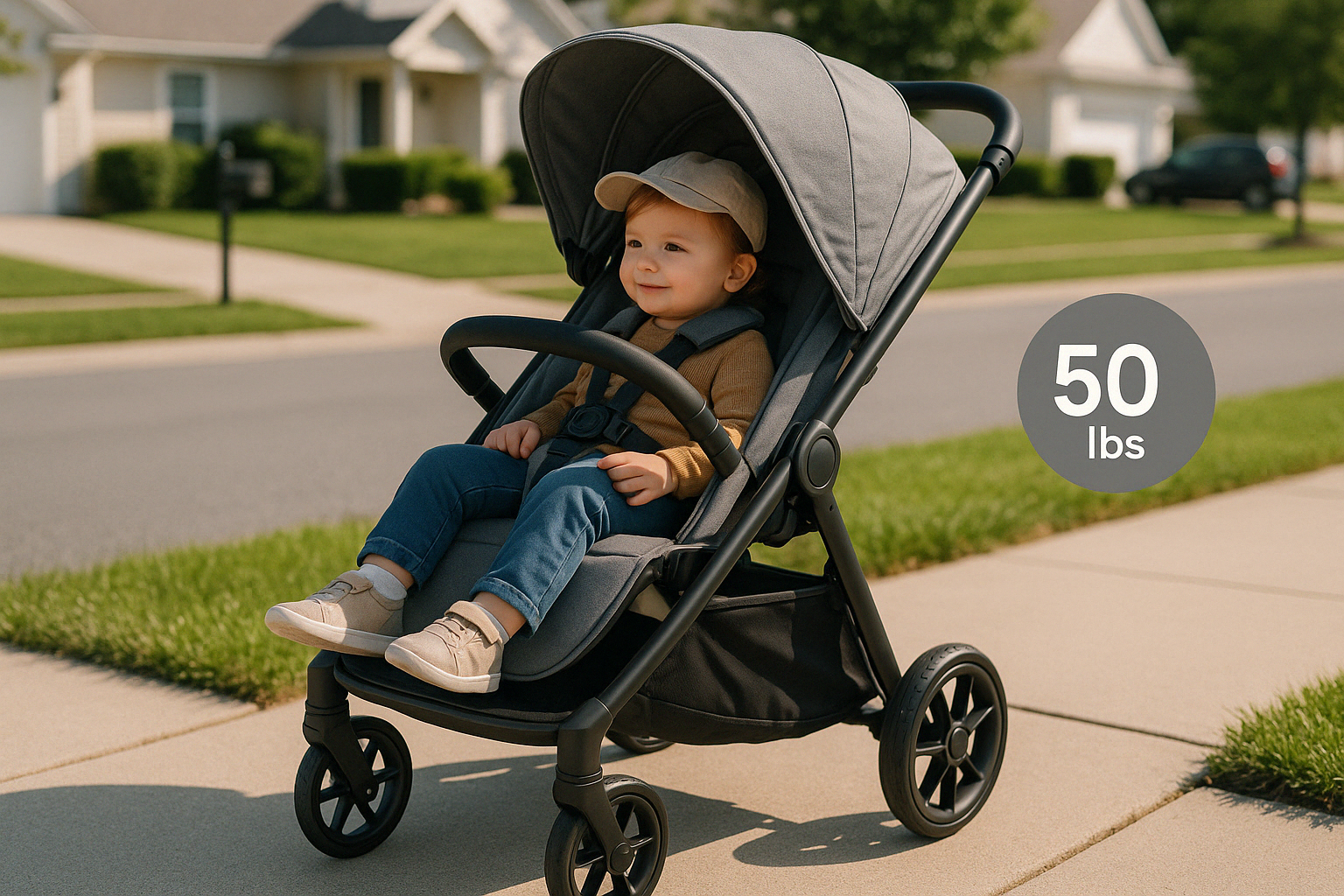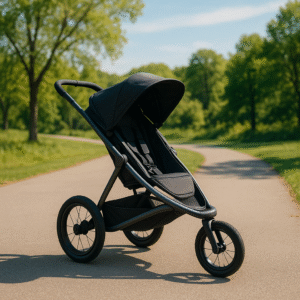Stroller Weight Limits: Top 3 Shocking Risks in 2025
Understanding the Safety Limits: When Weight Matters
Stroller weight limits typically range from 45-75 pounds for single strollers, with most standard models supporting around 50 pounds. Double strollers generally accommodate 45-50 pounds per seat, while specialty models like joggers or wagon hybrids may support up to 75 pounds per seat.
| Stroller Type | Average Weight Limit | Typical Age Range |
|---|---|---|
| Standard Single | 50 lbs (22.7 kg) | Birth to 4-5 years |
| Lightweight/Travel | 45-55 lbs (20-25 kg) | 6 months to 4 years |
| Jogging | 65-75 lbs (29-34 kg) | 6 months to 6+ years |
| Double (per seat) | 45-50 lbs (20-22.7 kg) | Birth to 4 years |
| Stroller Wagon | 55-110 lbs (total) | 1-8 years |
Every parent faces that moment – your child is growing, but are they getting too big for their stroller? Understanding stroller weight limits isn’t just about following rules; it’s about ensuring your child’s safety and protecting your investment. When a stroller is pushed beyond its designed capacity, the risks range from minor inconveniences like difficult steering to serious hazards such as structural failure or tip-overs.
Parents often overlook these limits, especially when rushing through a theme park with a tired kindergartener or loading up the storage basket with shopping bags. Yet exceeding these carefully calculated thresholds can compromise the stroller’s stability, strain the frame, and potentially lead to dangerous situations.
I’m James Mark, a product safety specialist with over 10 years of experience testing and evaluating stroller weight limits across hundreds of models to ensure they meet rigorous safety standards. My work has helped countless parents understand the critical balance between convenience and safety when selecting appropriate mobility solutions for their growing children.

Must-know stroller weight limits terms:
Understanding Stroller Weight Limits
That lightweight stroller that seemed perfect when your baby was six months old might not be the best fit as they grow into a curious toddler. Understanding stroller weight limits isn’t just about following rules—it’s about keeping your little one safe while preserving your stroller’s longevity and performance.
What Are Stroller Weight Limits?
Stroller weight limits are carefully calculated maximum weight capacities that ensure your stroller functions safely during everyday use. Think of them as guardrails that help you use your stroller as intended, not arbitrary restrictions.
These limits typically cover three important areas: the occupant weight limit (how heavy your child can be), the storage basket limit (how much you can stuff underneath), and the total load capacity (everything combined).
Many parents are surprised when they read their stroller’s manual and find specific guidance like: “Child weight limit: 50 lb (22.7 kg); Child height limit: 45 inches (114.3 cm); Maximum storage basket load: 10 lb (4.5 kg).” These numbers aren’t suggestions—they’re safety thresholds determined through extensive testing.
How Manufacturers Determine Weight Limits
Behind every stroller weight limit is a team of engineers who’ve put your stroller through rigorous testing. They’re not just guessing what might be safe.
“We test for everything from normal use to reasonably foreseeable misuse,” explains a product safety engineer who’s worked with major stroller brands. “Strollers undergo extensive testing that includes dynamic load testing, stability testing, and durability testing.”
Manufacturers consider numerous factors when setting these limits:
The frame materials and construction make a huge difference—aluminum frames might be wonderfully lightweight for travel, but they have different strength properties than steel frames. Joint and connection points are critical since they’re often the first to show stress under heavy loads. Even the wheel design and materials matter, as larger air-filled tires typically support more weight than small plastic wheels.
Strong braking systems become increasingly important as weight increases, and smart manufacturers build in safety margins above the stated limits for extra protection. All of these determinations must comply with regulatory standards like ASTM F833 in the United States.
Common Stroller Weight Limits Explained
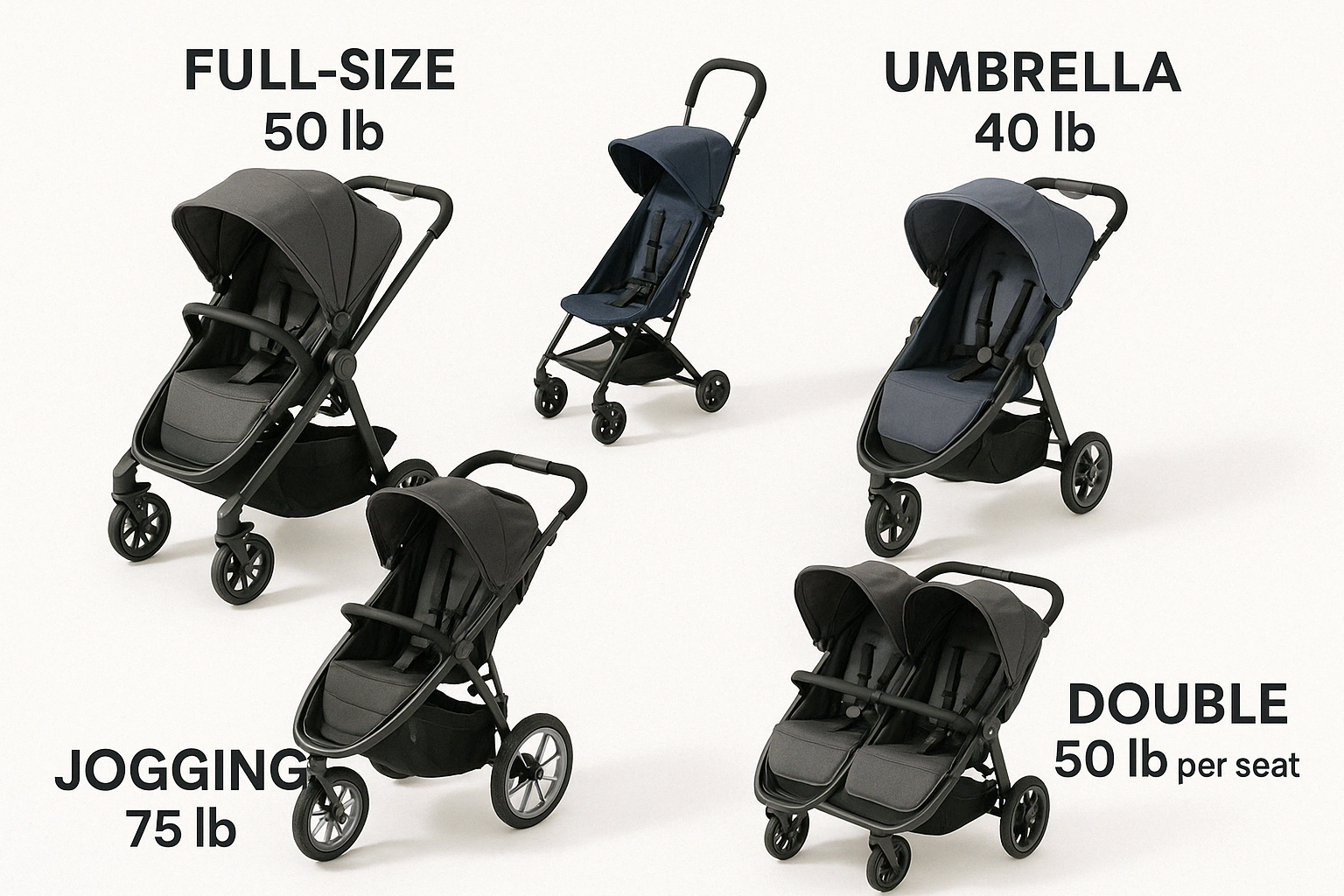
Not all strollers are created equal when it comes to stroller weight limits. Your standard full-size stroller typically supports around 50 pounds—enough for most children until they’re about 4-5 years old. The storage baskets underneath usually hold between 10-25 pounds of diaper bags, snacks, and shopping treasures.
If you’re a traveler, your lightweight travel stroller might have a slightly lower capacity, usually between 45-55 pounds. The Baby Jogger city tour™ 2 supports children up to 45 pounds, while the Nuna TRVL stroller accommodates children up to 50 pounds.
For the active parent, jogging strollers boast some of the highest single-seat capacities, often supporting 65-75 pounds. The BOB Gear Revolution Flex 3.0, for example, can handle up to 75 pounds, with improved suspension systems that accommodate the additional weight while maintaining a smooth ride.
Growing family? Double strollers typically support 45-50 pounds per seat. The Mockingbird Single-to-Double with dual toddler seats supports up to 45 pounds in each seat—perfect for twins or siblings close in age.
For families needing maximum capacity, stroller wagons are the heavyweight champions. The Veer Cruiser supports up to 55 pounds per seat, while some WonderFold Outdoor stroller wagons can handle a whopping 150-350 pounds total, depending on the model.
Height matters too. The UPPAbaby Vista’s toddler seat, for instance, supports children up to 50 pounds and 40 inches tall, while their Rumbleseat has the same weight limit but accommodates children only up to 36 inches tall. Their piggyback riding board supports up to 55 pounds, perfect for an older sibling who’s mostly walking but needs occasional breaks.
By staying within these carefully calculated limits, you’re not just following rules—you’re ensuring your stroller performs as designed and keeps your precious cargo safe on every trip, from quick grocery runs to all-day theme park excursions.
Risks and Consequences of Exceeding Stroller Weight Limits
We’ve all been there – your little one is tired at the zoo, you’ve got shopping bags hanging from every handle, and suddenly your stroller feels more like a loaded cargo truck. While it might seem harmless in the moment, ignoring those stroller weight limits can lead to serious problems that go beyond just making your stroller harder to push.
Impact on Safety and Performance
When you exceed your stroller weight limits, your once-nimble baby transporter transforms into something much less cooperative. That smooth one-handed steering? Gone. Now you’re using your full body weight just to make a simple turn around the corner at the mall.
The engineering behind strollers is precise – they’re designed to handle specific loads while maintaining stability and control. When we push past those limits, several things happen:
Your stroller becomes noticeably harder to maneuver. The front wheels might start to wobble unpredictably or stick instead of pivoting smoothly. What should be an easy walk becomes an arm workout as you wrestle with the steering.
Perhaps most concerning is what happens to your braking system. Those brakes that reliably hold your stroller in place on slight inclines? They’re calibrated for specific weight ranges. Add too much weight, and they might not fully engage or could fail entirely – especially on hills or slopes where you need them most.
Then there’s stability. An overloaded stroller becomes top-heavy and dramatically more likely to tip over, particularly when navigating curbs, bumpy sidewalks, or making quick turns to avoid obstacles.
“I never thought much about weight limits until my stroller nearly tipped backward when my 5-year-old hopped on the back while my toddler was seated,” shares Monica, a mom of three. “It was a wake-up call about how quickly things can go wrong.”
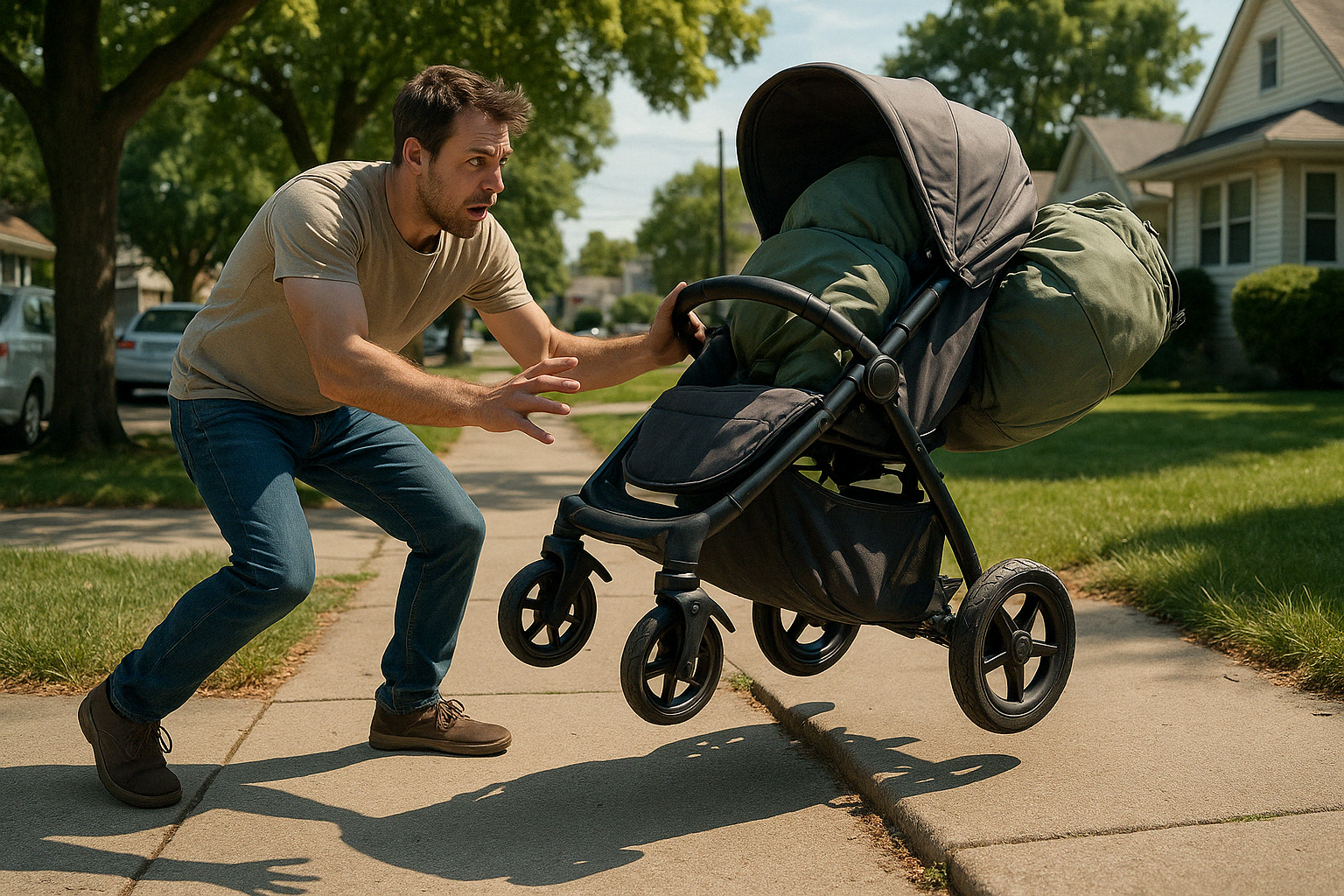
Potential Injuries to Children and Caregivers
The consequences of exceeding stroller weight limits aren’t just about inconvenience – they can result in real injuries to both children and parents.
For little ones, the most immediate risk comes from tip-over accidents. When a stroller becomes unstable and tips, children can suffer head injuries, cuts, bruises, or even more serious trauma. If the frame buckles or collapses under excessive weight, children might become entrapped or pinched between failing parts.
Parents and caregivers aren’t immune either. The physical strain of pushing an overloaded stroller can lead to back, shoulder, and wrist injuries. Many parents don’t realize they’re causing long-term damage to their bodies by regularly forcing an overweight stroller around.
According to research from the Consumer Product Safety Commission, emergency departments treat approximately 14,000 children under age 5 for stroller-related injuries each year. While not all of these incidents stem directly from exceeding weight limits, structural failures and tip-overs – two common results of overloading – rank among the leading causes of serious injuries.
As one pediatric ER doctor notes, “We see stroller injuries that could have been prevented by following basic safety guidelines, including respecting weight limits. These aren’t arbitrary numbers – they’re safety thresholds.”
The scientific research on stroller-related injuries underscores the importance of taking manufacturer guidelines seriously.
Legal and Warranty Implications
Beyond the physical risks, there are practical consequences to ignoring those stroller weight limits printed in your owner’s manual.
First, you can kiss your warranty goodbye. Manufacturers are very clear that using their products beyond stated weight capacities voids all warranty coverage. This means if your stroller frame cracks or a wheel breaks off – even if it’s due to a manufacturing defect unrelated to weight – you’re likely on your own for repairs or replacement.
The financial implications can extend further. If an injury occurs because you exceeded the stroller’s weight capacity, insurance companies might deny claims, arguing the product was being used improperly. This could potentially leave you responsible for medical bills and other costs.
“WARNING! DEATH or SERIOUS INJURY can occur. Read and follow all warnings and instructions. Failure to do so could result in serious injury or death.” This stark language from one stroller manual isn’t there just to fill space – manufacturers have a legal obligation to warn consumers about proper use.
Manufacturers have determined these limits through extensive testing and engineering analysis – not to restrict your stroller’s usefulness, but to ensure it remains safe throughout its lifetime. When we respect these guidelines, we’re not just following rules – we’re protecting our children and ourselves.
How to Ensure You’re Within the Stroller’s Weight Limit
Keeping tabs on your stroller’s weight capacity isn’t rocket science, but it does require a bit of attention as your little one grows. After all, that tiny baby will transform into a walking, talking toddler faster than you can say “growth spurt”!
Regularly Monitor Your Child’s Growth
Kids don’t just grow overnight—except sometimes, it feels like they do! One day they’re fitting perfectly in the stroller, and the next, they seem to have sprouted an extra inch. To stay within stroller weight limits:
Those regular pediatrician check-ups aren’t just for shots and developmental milestones—they’re the perfect opportunity to note your child’s current weight. Jot it down and compare it to your stroller’s capacity when you get home.
Between doctor visits, your bathroom scale can become your best friend. Many parents find it helpful to weigh their child every month or so, especially during those rapid growth phases.
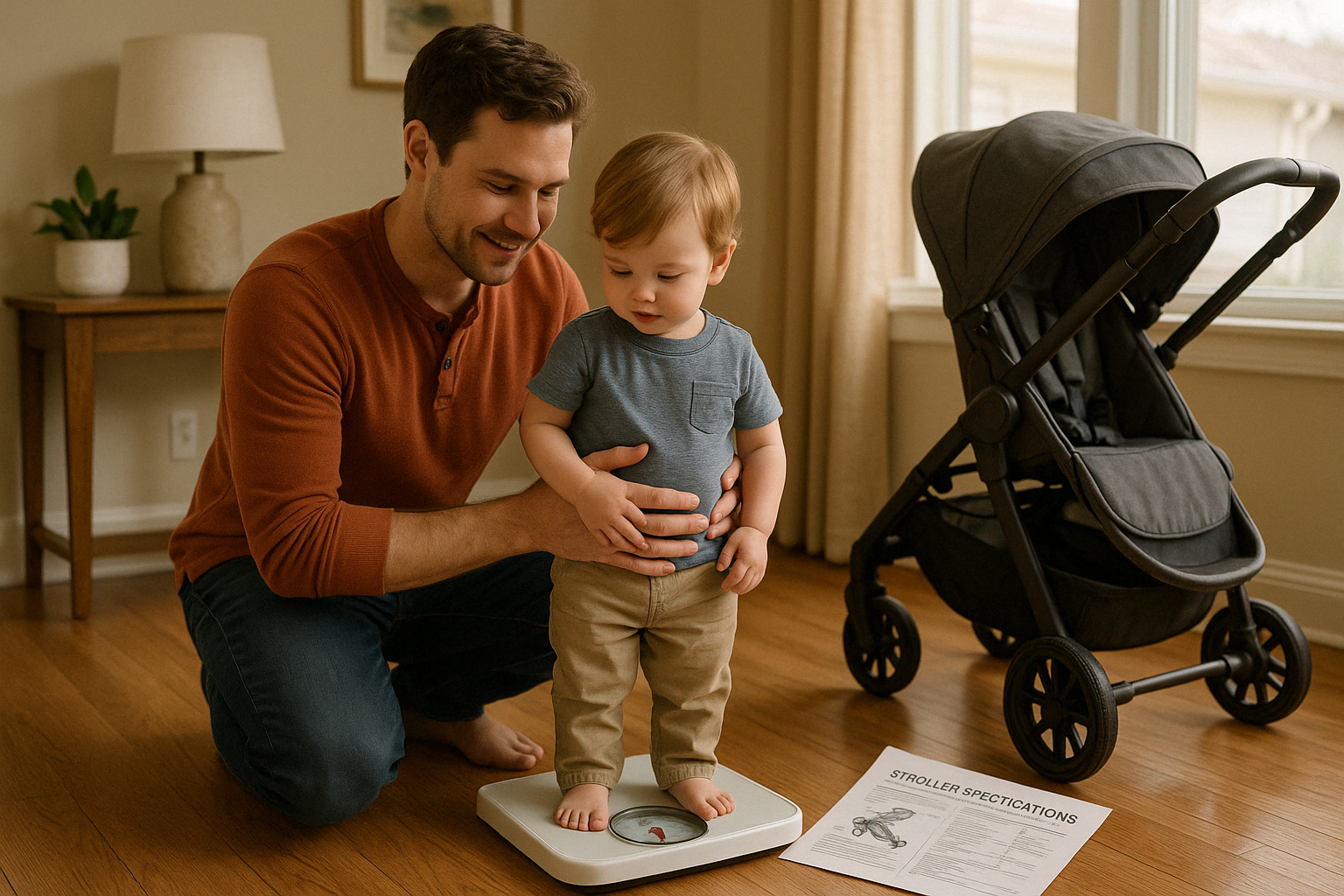
Don’t wait until your kiddo looks comically oversized in their stroller—by then, you’re likely well past the safety threshold. The CDC provides helpful Growth Charts that can help you anticipate when your child might approach your stroller’s weight limit. For example, most 4-year-olds weigh around 40 pounds, which is getting dangerously close to the typical 50-pound limit on standard strollers.
Considering Accessories and Extra Weight
When manufacturers specify stroller weight limits, they’re talking about the total package—not just your precious cargo. That fully loaded diaper bag? It counts. Those shopping bags from your mall excursion? They count too.
Your diaper bag alone might weigh 5-10 pounds when stocked with diapers, wipes, extra clothes, and snacks. Add a few shopping bags during an afternoon out, and you could easily add another 10-15 pounds to your stroller’s load.
One clever mom shared her solution: “I keep a small luggage scale in my diaper bag to quickly check if I’m overloading the storage basket, especially when shopping. It’s saved me from pushing an overloaded stroller more times than I can count!”
Remember those stroller specifications? When UPPAbaby says “The basket has a 30 lb weight limit, and the toddler seat is designed for children up to 50 lbs,” they’re giving you the complete picture of what your stroller can safely handle. That means your combined weight—child plus basket contents—shouldn’t exceed 80 pounds.
Don’t forget about those handy accessories either. Weather shields, snack trays, and cup holders add minimal weight individually, but together they contribute to the total load. And if you’ve added a riding board for a sibling? That’s not just extra weight—it can also affect your stroller’s balance and handling.
Signs Your Child Has Outgrown the Stroller
Weight isn’t the only indicator that your child might need a stroller upgrade. Visual and functional clues can tell you it’s time for a change:
When your little one’s head starts bumping against the canopy, that’s nature’s not-so-subtle hint that they’ve exceeded the height limit. As one product manual bluntly puts it: “If a child’s head begins to bump against the canopy, it indicates that the stroller has outgrown its usability for that child.” This typically happens when kids reach about 40-42 inches in height, often around 4-5 years old.

Pay attention to your child’s comfort level too. If they’re sitting with knees sharply bent or legs awkwardly dangling over the edge, they’re probably not comfortable—and comfort issues often signal that safety could be compromised as well.
The stroller itself will give you clues too. If you suddenly find yourself using extra muscle to push or steer, or if the stroller feels “different” under your hands, the weight limit might be exceeded. Listen for unusual sounds—creaking, popping, or grinding noises are the stroller’s way of crying for help. And keep an eye on the frame—any visible bowing or flexing when your child sits down is a red flag that shouldn’t be ignored.
Stroller weight limits aren’t suggestions—they’re safety guidelines carefully calculated by engineers who understand exactly how much stress each component can handle before compromising your child’s safety. When in doubt, it’s always better to upgrade to a higher-capacity option than to push the limits of your current model.
Options for Children Who Exceed Standard Stroller Weight Limits
When your child outgrows a standard stroller, you’re not left stranded without options. There’s a whole world of specialized mobility solutions designed specifically for bigger kids or those with special needs. Let’s explore what’s available when your little one isn’t so little anymore.
High-Capacity Strollers and Their Features
If your child has exceeded the typical 50-pound limit of standard strollers, high-capacity models offer a perfect solution. These aren’t just regular strollers with higher weight ratings—they’re completely re-engineered with stronger materials, reinforced frames, and improved safety features to keep larger children secure and comfortable.
The BOB Gear Revolution Flex 3.0 stands out with its impressive 75-pound weight capacity. Its reinforced aluminum frame provides exceptional durability without becoming too heavy for parents to manage. At 28.5 pounds, it’s substantial but still manageable for most adults. The air-filled tires and improved suspension system make pushing a heavier child feel surprisingly effortless, even on rough terrain.
Another excellent option is the Baby Jogger City Mini GT, supporting up to 65 pounds. Parents love its all-terrain wheels with built-in suspension that smooths out bumpy sidewalks. The one-hand quick-fold technology is a lifesaver when you’re juggling a bigger child and all their gear. At 21.4 pounds, it’s also relatively lightweight considering its capacity.
For families who love outdoor trips, the Thule Urban Glide offers that same 75-pound weight capacity in a sleeker 23-pound package. Its swivel front wheel with tracking adjustment ensures you maintain control even with a heavier load. The integrated twist hand brake provides extra security when navigating hills—something particularly important when pushing a larger child.

The Veer Cruiser takes a different approach as a hybrid stroller-wagon. With a capacity of 55 pounds per seat (110 pounds total), it’s perfect for heavier children or multiple kids. Its aircraft-grade aluminum construction provides exceptional strength while keeping the weight manageable. Many parents appreciate its versatility—it can adapt to hold infant car seats but is sturdy enough for school-aged children.
What makes these high-capacity strollers special isn’t just their weight limits. Their entire structure is designed differently, with reinforced frame joints that distribute weight more effectively and improved suspension systems that maintain performance even under heavier loads. The larger, more durable wheels support additional weight while keeping the stroller maneuverable, and stronger braking systems ensure you can stop safely, even when fully loaded.
As one product engineer explains, “These high-capacity strollers often use 6061 aircraft aluminum in their frames—the same material used in bicycle frames designed to withstand significant stress. It’s not just about making things bigger; it’s about smart engineering.”
Alternative Mobility Solutions
Sometimes, thinking outside the traditional stroller box leads to the best solutions for growing families.
Stroller wagons have revolutionized family mobility with some of the highest weight capacities on the market. The WonderFold Outdoor models support between 150-350 pounds total—enough for multiple children of various ages. The Keenz Stroller Wagon holds up to 110 pounds while weighing just 32 pounds itself.
What makes these wagons so practical is their versatility. Most feature both pull and push handles, giving you options depending on terrain and your child’s weight. Their canopies provide essential sun protection, and the ample storage space means you’re not sacrificing practicality for capacity. With seating for 2-4 children, they’re perfect for families with multiple kids of different ages.
Some parents get creative by repurposing double strollers for a single larger child. The combined weight limit of both seats can sometimes accommodate older children who’ve outgrown standard options. The extra space gives them room to sit comfortably without feeling cramped. The Lightweight Double Stroller Side by Side offers excellent options that can be adapted for single larger children while providing the stability needed for heavier weights.
For children with mobility challenges who may need stroller support well beyond typical age ranges, special needs strollers offer the perfect solution. These specialized mobility aids often support weights of 100+ pounds and include thoughtful features like fully reclining seats, positioning supports, and larger wheels for all-terrain use. They prioritize comfort and support for extended periods of sitting, which is essential for children with special needs.
One parent shared her experience: “Finding a stroller that could accommodate my 8-year-old was challenging until we finded special needs strollers. The higher weight capacity and supportive seating made a world of difference for our family outings. For the first time in years, we could go to the zoo without worrying about my son getting tired or uncomfortable.”
When your child exceeds standard stroller weight limits, you have options—whether it’s upgrading to a high-capacity model, exploring stroller wagons, or finding specialized solutions that meet your family’s unique needs. Safety and comfort don’t have to be sacrificed just because your child is growing.
Frequently Asked Questions About Stroller Weight Limits
What Happens If I Exceed the Stroller’s Weight Limit?
Let’s be honest – we’ve all been tempted to push the limits on occasion. Maybe your 4-year-old is tired after a long day at the zoo, or perhaps you’ve loaded up the storage basket with shopping bags. But exceeding stroller weight limits isn’t like squeezing into jeans that are a bit too tight – it comes with real safety concerns.
When you go over the weight limit, you’ll notice the effects immediately. Your once-nimble stroller suddenly feels like it’s dragging through mud. Steering becomes a workout, especially around corners. That smooth ride? Gone. Your stroller might even make concerning creaking sounds as the frame strains under the extra weight.
The long-term damage is even more troubling. Components like wheel bearings and axles wear out faster than they should. The frame can develop stress fractures or begin to warp. Even the fabric seat and storage basket will stretch and tear prematurely. One mom told me, “I ignored the weight limit for months and couldn’t figure out why my stroller’s front wheel wobbled so badly – until a wheel actually broke off during a walk!”
Most concerning are the safety risks. An overloaded stroller becomes tippy, especially when navigating curbs or bumpy sidewalks. The brakes might not hold properly on slopes. In worst-case scenarios, parts can fail suddenly, potentially causing injuries to your child.
As one manufacturer plainly states in their manual: “DO NOT use the stroller with a child heavier than the weight limit. Doing so will cause excessive wear and stress on the stroller and could cause a hazardous unstable condition.”
How Do Stroller Weight Limits Correlate with Age and Height?
Parents often wonder how stroller weight limits translate to their growing child’s development milestones. While every child grows at their own pace, here are some helpful benchmarks:
Most 3-year-olds weigh between 30-40 pounds, comfortably within the typical 50-pound limit of standard strollers. By age 4, children typically reach 35-45 pounds, and 5-year-olds often weigh 40-50 pounds – right at the upper limit for many models. Once children hit age 6, they frequently weigh 45-55 pounds, which exceeds standard stroller capacities.
Height often becomes the limiting factor before weight does. Most strollers have a height limit around 40-45 inches. The average 4-year-old stands about 40 inches tall, while 5-year-olds typically reach 42-45 inches. When your child’s head bumps against the canopy or their legs dangle uncomfortably, it’s a clear sign they’ve outgrown the stroller regardless of weight.
“I thought my daughter was fine in her stroller because she only weighed 42 pounds,” shares one dad. “But at 43 inches tall, she was cramped and uncomfortable. Her head kept hitting the canopy every time we went over a bump!”
It’s worth noting that the CDC Physical Activity Guidelines recommend plenty of active movement throughout the day for young children. While strollers are incredibly helpful, especially for longer outings or tired little legs, they work best as a complement to—not a replacement for—physical activity as children grow.
Are Weight Limits Different Between Single and Double Strollers?
Yes, there are significant differences in how stroller weight limits work between single and double models, and understanding these distinctions is crucial for parents with multiple children.
Single strollers typically support between 45-50 pounds for standard models, with premium or jogging versions sometimes accommodating up to 65-75 pounds. Their storage baskets usually hold between 10-30 pounds of extra gear. They’re designed with a specific balance point and weight distribution in mind.
Double strollers operate differently. Rather than one overall limit, they specify per-seat weight limits – typically 45-50 pounds per seat. This means a total capacity of 90-100 pounds for both children combined. Many double strollers also have specific weight distribution requirements – the manufacturer might recommend placing the heavier child in the rear seat for better stability and handling.
The frames on double strollers are reinforced to handle the distributed weight of two children, but this doesn’t always mean each seat can hold as much as a single stroller. For example, the Mockingbird Single-to-Double Stroller supports 45 pounds per seat in double configuration, slightly less than their single stroller’s 50-pound capacity. This reduction accounts for the changed dynamics when supporting two children simultaneously.
Double strollers also typically feature larger or more numerous wheels and special balance considerations to maintain stability with the increased load. Their storage baskets are often more generous but still have similar weight restrictions to prevent tipping.
A mom of twins shared: “When my girls were infants, our double stroller was perfect. But as they grew, I had to be more mindful of the weight limits. By age 4, we were right at the maximum capacity, and I could really feel the difference in how the stroller handled compared to when they were smaller.”
For parents juggling multiple little ones, understanding these differences ensures you’ll get the maximum safe use from your stroller investment – whether you have twins or children of different ages.
Conclusion
Understanding and respecting stroller weight limits isn’t just about following rules—it’s about keeping your little one safe while getting the most value from your investment. After all, a stroller is probably one of the most-used baby items you’ll purchase, so making sure it lasts (and performs safely) matters.
Throughout this guide, we’ve seen how exceeding these carefully calculated limits can lead to wobbly handling, potential safety hazards, and premature wear on your favorite set of wheels. Think of these limits as your stroller’s way of communicating its boundaries—push beyond them, and you’re entering risky territory.
Remember these important takeaways as your child grows:
Know your numbers. Take a few minutes to find your stroller’s specific weight limits—both for the seat and those handy storage areas underneath. That manual you tucked away in a drawer? It’s time to dig it out!
Keep an eye on those growth charts. Kids have a funny way of growing when we’re not looking! Regularly compare your child’s weight against your stroller’s capacity, especially during those impressive growth spurts that seem to happen overnight.
Watch for the telltale signs. Your child might be outgrowing their ride if their head is brushing against the canopy, their legs dangle uncomfortably, or they simply look cramped. These visual cues often appear before you’ve hit the actual weight limit.
Explore new options when needed. When you start approaching those maximum limits, it’s time to consider alternatives like high-capacity strollers, stroller wagons, or perhaps transitioning to more walking for shorter trips.
Always prioritize safety. It might be tempting to exceed the limit “just this once” for that long day at the zoo or theme park, but those limits exist for good reasons. Your child’s safety is worth the extra planning or investment in appropriate equipment.

At BabbyStrollers.com, we understand the journey of finding just the right stroller for each stage of childhood. Our comprehensive buying guides are designed to help you steer these important decisions, whether you’re shopping for your very first stroller or looking for options as your child grows.
I’ll never forget what one parent shared with us: “I was tempted to keep using our favorite stroller even though my son had exceeded the weight limit. After learning about the safety risks, we invested in a higher-capacity model. The peace of mind was worth every penny.” This perfectly captures why respecting these limits matters.
The right stroller does more than just accommodate weight—it provides safe, comfortable transportation for your child through every wonderful, messy, trip-filled stage of their early years. Whether you’re strolling through the neighborhood or tackling a day of errands, knowing you’re within those stroller weight limits means one less thing to worry about in the wonderfully complex world of parenting.
For personalized recommendations based on your child’s specific measurements and your family’s unique needs, we invite you to explore our selection of strollers designed with growing families in mind. Happy strolling!

